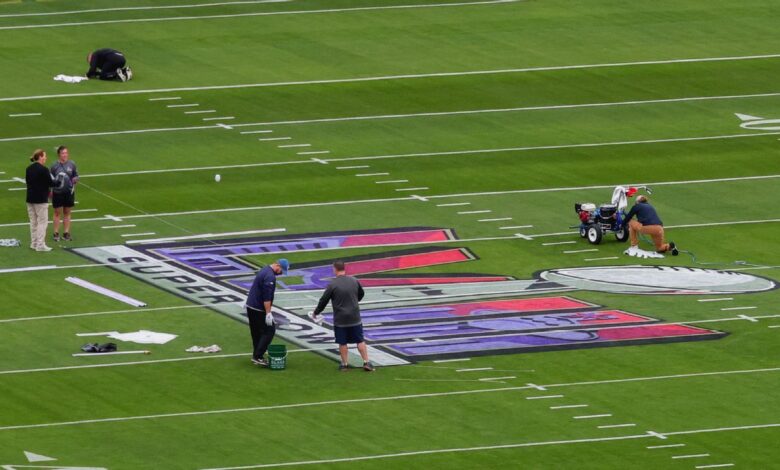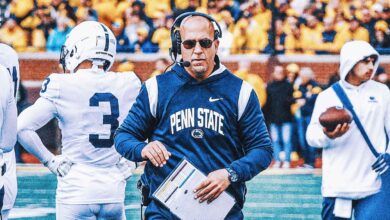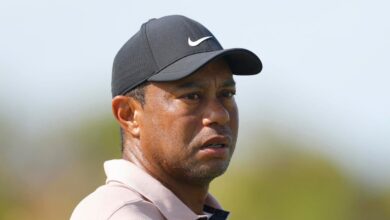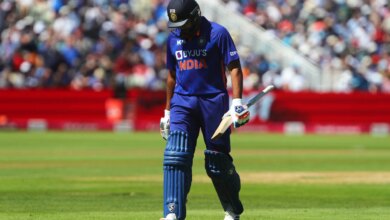Will Las Vegas Super Bowl field hold up after NFL turf issues?

LAS VEGAS — On Jan. 9, two days after the Las Vegas Raiders‘ season finale at Allegiant Stadium, newly appointed NFL field director Nick Pappas posted a photo on X of the Raiders’ rollaway grass field being ripped up to make way for the one-time-use field for Super Bowl LVIII to be played 33 days later.
In 12 posts over the next 30 days, Pappas gave his followers a behind-the-scenes look at the installation and preparation of this year’s Super Bowl field. He peeled back the curtain on how the grass was harvested, rolled up and then laid out in a tray outside the stadium. Pappas shared photos of the field being lined and the logos painted. On Wednesday, he posted a video of the tray being rolled into the stadium.
POV: #SBLVIII field rolling into @AllegiantStadm. #FromTheField pic.twitter.com/2198AdhT3v
— Nick Pappas (@NPappas23) February 8, 2024
At Super Bowl LVII at State Farm Stadium in Glendale, Arizona, the NFL made greenskeepers available to the media for interviews 12 days before kickoff. This year, until his Thursday meeting with the media, Pappas’ X feed had been the only window into the field he has curated. He hopes the field won’t become the storyline, as it did for Super Bowl LVII.
Last season’s Super Bowl field, prepared by former NFL field director Ed Mangan, gave the Kansas City Chiefs and Philadelphia Eagles fits. Players slipped when they tried to cut as upturned divots dotted the field. Many, including Eagles quarterback Jalen Hurts, had to change their cleats.
“I’m not going to lie, it was the worst field that I’ve ever played on,” Eagles outside linebacker Haason Reddick said after the game.
The problem resulted from the field’s treatment in the week before the game, a source familiar with the process told ESPN. The NFL has declined multiple requests to address last year’s issues publicly. Its only public comment was a statement issued after the game:
“The State Farm Stadium field surface met the required standards for the maintenance of natural surfaces, as per NFL policy. The natural grass surface was tested throughout Super Bowl week and was in compliance with all mandatory NFL practices.”
The field system at Allegiant Stadium in Las Vegas was modeled after the one at State Farm Stadium in Arizona. Allegiant Stadium also has a grass field that sits on a tray that’s rolled in for games and rolled out for maintenance, watering and sun. How the field will hold up Sunday at Allegiant Stadium is a major question. And rightfully so. It’s similar to last year’s field.
The tray containing the field remained outside during a rainstorm Monday during the opening night ceremonies inside Allegiant Stadium. It was uncovered during the day, exposed to the elements, but by the time the event ended, after 8 p.m. PT, it was covered by a tarp.
“Grass doesn’t love that,” said Pappas, who spoke to the media Thursday, referencing the weight of the tarp — along with the weight of the halftime show foot traffic — being on top of the field for extended periods of time.
The tray was brought in for a few hours Tuesday, Pappas said, for halftime show rehearsals, before going back out into the elements. It remained outdoors all day Wednesday before being brought in for good Thursday afternoon. It was covered with a tarp again, so Usher could practice for his halftime show, to be removed at 7 p.m. PT Thursday after he was finished.
“We wanted to keep it outside as long as possible,” Pappas said, acknowledging that last year’s field was brought in on Wednesday of Super Bowl week.
Another look at the #SuperBowl field, from the ground level… pic.twitter.com/QNenNFeoXS
— Paul Gutierrez (@PGutierrezESPN) February 8, 2024
One key difference between the Arizona and Las Vegas systems is the Allegiant Stadium tray is equipped with heating coils. Grass in the desert goes dormant in the winter months, making it look like hay, a groundskeeping source told ESPN. Allegiant Stadium counters that by having heating coils in the tray to fool the grass into thinking it is still warm so it will keep growing. There were also large fans behind the team bench areas Thursday to better circulate the air in the enclosed stadium.
Asked whether last year’s Arizona experience was a factor in moving the field, made of Tifway II Bermuda grass from central California, indoors a day later, Jeff Miller, NFL executive vice president of communications, public affairs and policy, said he wasn’t sure whether there was a connection.
“When they’re moving it out there, during the course of game week, they want to make sure it’s getting some sun, right?” Miller said Thursday. “So it lives outside oftentimes in the morning. The rain over the last couple of days has affected how they’ve chosen to treat it.
“They obviously want to be careful around halftime rehearsals and stuff to make sure that they have time to remediate the field after people have been running up and back on it, so it performs as well as it can.”
LAST YEAR’S SUPER Bowl field strand was chosen by Mangan, who had worked the field at 35 Super Bowls. Tahoma 31 is a Bermuda hybrid overseeded with rye created at Oklahoma State University. The USGA funded its creation, and the strand has become popular with NFL and MLB teams as well as golf courses across the country.
It was developed to withstand cold, drought, disease and wear and recover well from traffic — all reasons Mangan chose it. The Chiefs and Eagles both have Tahoma 31 in their stadiums, as do the Rose Bowl, Los Angeles Coliseum, Dodger Stadium, Angel Stadium and Soldier Field, among others.
One decision, however, changed the course of how the field played last year.
About five days before the game, the field at State Farm Stadium was rolled in, “which is way longer than it was supposed to be in there,” according to a source familiar with the process. There were two primary reasons for the early arrival: (1) So rehearsals for the national anthem, Rihanna’s halftime show and other game-day entertainment could take place on the field and (2) so temporary stands and suites could be built on the south end of the stadium after the sod was rolled in.
Right before the Super Bowl field was rolled in, Mangan’s team watered it, multiple sources said. Immediately, the groundskeepers who were helping prepare the field knew it was a bad decision.
“It got put inside the stadium way too early and it was soaking f—ing wet when it went in there,” one source familiar with the process said. “And once it got in there, it couldn’t breathe. It was musty in there. It stunk. And, yeah, it was disgusting.”
The field was covered with a tarp, which had the lines of a field painted on it so the shows could rehearse and hit their marks for about eight hours a day, the source said.
Once rye grass gets wet, it can become exceedingly slippery, said Dr. Yanqi Wu, who created Tahoma 31. Wu was not part of the NFL’s field process a year ago, and all of his observations have come from afar. Low air moisture would have helped dry out the rye grass, said Wu, who added that that becomes difficult indoors when air flow and sunlight are low but humidity tends to be higher.
“It was taking a beating, and it was dead by game time,” the source said. “It was an ice skating rink.”
IN MARCH, THE NFL and Mangan parted ways after more than three decades. Mangan told ESPN in May that it was a mutual decision and that it wasn’t a result of last year’s Super Bowl field. He said the reason for the move was the NFL wanted a full-time field director but he wasn’t able to commit to that because he’s also the Atlanta Braves‘ field director.
The NFL promoted Pappas, whose title last year was NFL field surface director. Miller said the NFL has appreciated having Pappas full time as the “key person” making decisions, some of which have differed from 2023.
Last year, on Feb. 6, Phil Bogle, the NFL director of game operations, posted a photo of the Super Bowl logos getting prepared. Pappas posted a photo of the logo being painted on this year’s field on Jan. 31, a week earlier.
A year ago, the field was installed 27 days before the game. This year the process started 31 days before the game. Last year, State Farm Stadium was finished with football games by New Year’s Day. The CFP semifinals were played the night before at the Fiesta Bowl, and the Cardinals were on the road for the last two games of the season, essentially giving the NFL the stadium for seven weeks.
The NFL took over Allegiant Stadium after the Raiders’ final home game Jan. 7. A source familiar with the Las Vegas field preparation told ESPN that even though Allegiant Stadium has an artificial grass field used by UNLV that is under the natural grass tray, rehearsals for Usher’s halftime show need to take place on the game field to ensure the lighting for the show is correct.
“They put giant lighting rigs up in the rafters, and they sit there and shoot lights at the field for hours on end,” the source said. “And if the actual field isn’t in there, the lights are going to be off because it’s like a difference of 4½, 5 feet.”
The field at Allegiant Stadium was not the only grass under scrutiny in Las Vegas this week.
The 49ers, who are practicing at UNLV’s facility 4 miles from Allegiant Stadium, had an issue with the natural grass field installed on the artificial turf field being too soft. The NFL hardness score for fields averages 78, with no field being less than 70. The 49ers’ field was considered in the 50s, sources told ESPN’s Adam Schefter.
“You mean the natural grass surface that we put down?” NFL commissioner Roger Goodell said when asked at his news conference Monday. “Listen, that work is being done every single day. We’ve had 23 experts out there. We’ve had the union out there. All of them think it’s a very playable surface. It’s softer than what they have practiced on, but that happens.
“It’s well within all of our testing standards. It is something that we think all our experts, as well as neutral field inspectors, have all said, unanimously, that it’s a playable field.”
The early issues with the practice field feel like déjà vu.
“Playable is not the same thing as high quality,” said NFLPA president JC Tretter. “So we can’t kinda talk out of both sides of our mouth on this.”






